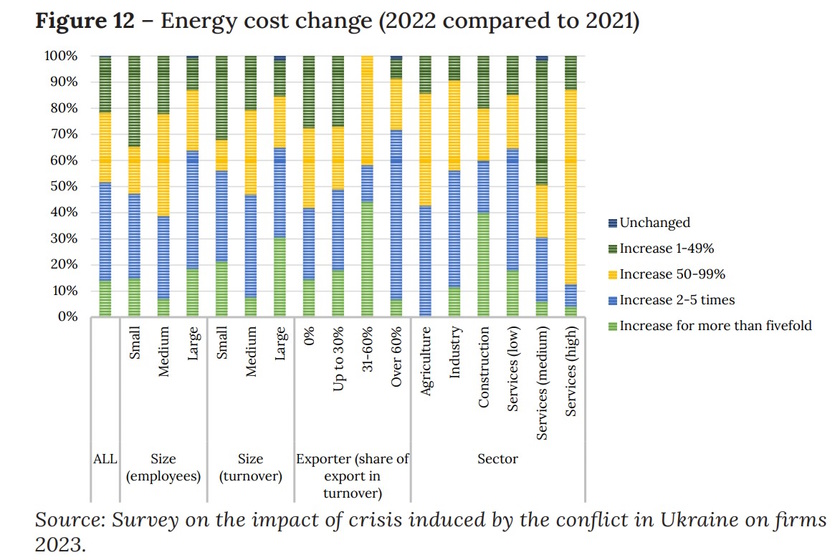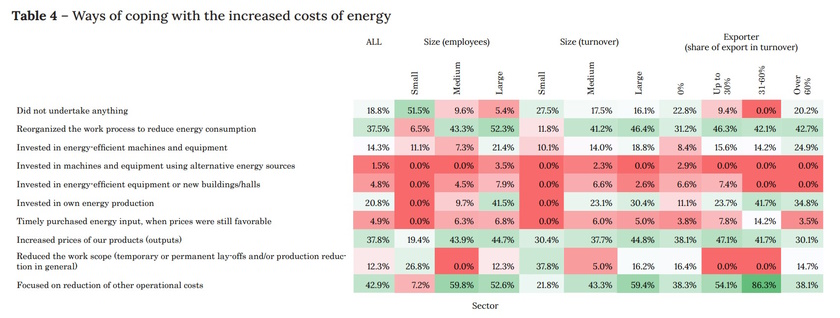
Photo: Finance Think
For more than a third of firms in North Macedonia, the war in Ukraine has led to a twofold to a fivefold jump in the price of the main energy input in 2022, according to a study published by Finance Think, an independent and non-for-profit economic research and policy institute. Electricity was the primary energy source for almost three quarters of respondents.
Finance Think’s main recommendations for firms is to opt for supply with a fixed or guaranteed price and to produce electricity for self-consumption. The advice for the authorities is to upgrade the grid to integrate such new facilities, secure storage capacities, simplify procedures for connection, and provide financial support.
Apart from the analysis of the impact of war in Ukraine on businesses and the recommendations on what to do to help them, the study covered the activities they undertook to cope with the soaring energy costs.
Electricity is the primary source of energy for 73.1% of firms

North Macedonian firms rely mostly on electricity as the primary source of energy (73.1% of respondents), while oil and its derivatives are ranked second (24%). There are no stark differences when firms are observed by size, but only by sector.
For more than a third of firms (37.6%), the increase in the price of the key energy input ranged twofold to fivefold between 2021 and 2022, according to the study, called The impact of the crisis induced by the conflict in Ukraine on firms in North Macedonia: Evidence from a micro-survey.
The impact was stronger for large firms (in turnover terms) as they have been purchasing electricity on the open market. The survey registered a share of 30.7% in the category that had costs more than five times higher than in 2021.
According to the study, the increases in energy costs have been the largest in construction – 40% of firms reported a more than fivefold increase. The lowest rise was registered in medium-pay services, where 47.7% said they paid up to 50% more than in the previous year.
More than a fifth of firms decided to produce power for self-consumption
The largest part of the companies in the survey (42.9%) turned to cutting operational costs to cope with the increased energy expenses. Researchers said 37.8% raised product prices. The third most frequent measure (37.5%) was to reorganize the work process to reduce energy consumption, followed by a share of 20.8% of respondents that said they invested in energy production for their own needs, the study reads.
According to the analysis, an expansion in the deployment of self-consumption energy capacities, in most cases photovoltaics, was evident last year and so far in 2023.
Of note, the upward trend of investments in renewable energy in North Macedonia, mostly in solar power plants, accelerated this year after a record-breaking 2022.
The sheer majority of small firms did not undertake anything to cope with the soaring energy cost. The study’s authors explained that they operate in a regulated market, but added it could also reflect the group’s limited resources for a response to shocks.

Institute recommends to firms to produce own electricity
There are four recommendations to overcome the impact of the energy crisis on companies.
For large firms, the price of electricity was the most critical factor, as they purchase it on the open market, so Finance Think proposed a model to support them in times of surging costs.
The straightforward answer – or request by firms – is usually to obtain a fixed (guaranteed) price from the government for a certain period of time, or tax reliefs, the authors said. Still, they acknowledged it may be fiscally unsustainable.
A longer-term alternative for larger companies is to invest in capacities for the production of electricity for self-consumption while the government’s role should be to simplify all the necessary procedures.
It should also invest in the electricity transmission network to sustain new connections and to support the investments in electricity-storing capacities (batteries) to prevent a large share of produced electricity from being wasted.
The study noted the expansion lately of financing mechanisms for both firms and households for investments in their own capacities for electricity production, but warned that there aren’t enough options.









Be the first one to comment on this article.